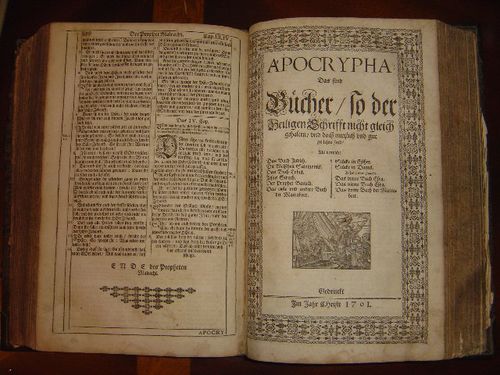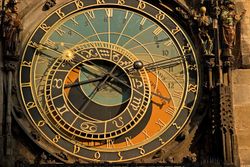Category:OT Apocrypha Studies
Highlights
History of research
The corpus of the OT Apocrypha or Deuterocanici owes its existence to the polemics of the Reformation era and was sanctioned by the Council of Trent in 1546.
The Protestant reformers acknowledged only the books also found in the Rabbinic Canon or Hebrew Bible as inspired scripture in the Old Testament. The Council of Trent reacted by affirming the larger canon of the traditional Roman Catholic Church, based on the Latin Vulgate: “If any one receive not, as sacred and canonical, the said books entire with all their parts, as they have been used to be read in the Catholic Church and as they are contained in the old Latin Vulgate . . . let him be anathema.”
The development of the corpus
This different approach resulted in a different treatment of the material within the Protestant and the Catholic tradition.
The first Protestant collection of OT Apocrypha by Taverner in 1549 published as a separated corpus texts originally printed as part of the Old Testament (from the 1939 Taverner's Bible, where they were still calle "Hagiographa") and included the apocalyptic 4 Ezra
On the other hand, the major Roman Catholic commentary of the 16th century, the Biblioteca Magna by Sixtus of Siena in 1566 included these texts (with the exception of 4 Ezra) in the Old Testament, only by giving them the label of deuterocanonici in recognition of the fact that their canonicity had been disputed.
While the Protestant tradition downplayed the religious authority of the OT Apocrypha, the Catholic tradition saw in them the canonical foundation of some distinctive Catholic doctrines such as the legitimacy of Church's property (see Expulsion of Heliodorus from the Temple) or the practice of intercession for the dead (see Judas' Prayer for the Dead).
This distinction in the treatment of the material within the Protestant and Catholic traditions has shaped the foundations of modern research; see OT Apocrypha Studies.
One of the first major consequences of the birth of the corpus of the OT Apocrypha / Deuterocanonici was the gradual emergence (since the beginning of the 18th century) of the companion corpus of the OT Pseudepigrapha (which Catholics called OT Apocrypha) to collect all the many other ancient books that before the 16th century had shared with the OT Apocryphal texts the same destiny of being at the fringes of the ancient Jewish and Christian canons.
The publication in 1795 of Eichhorn's Einleitung mark the beginning of modern research in the OT Apocrypha. Ever since introductions to and edition of OT Apocrypha have been frequently published as parts of the Old Testament in the Catholic world and in the Protestant world, sometimes as autonomous works, sometimes as an appendix to the Old Testament, sometimes in association with the OT Pseudepigrapha and more recently as part of Second Temple Literature; see OT Apocrypha Intro.
The Old Testament Apocrypha have been published (in the original language or in translation) in many editions of both the Bible and the Old Testament or as a separate corpus or sometimes, together with the OT Pseudepigrapha.
Likewise, general Introductions to the OT Apocrypha are found in many commentaries or introductions to either the Bible or the Old Testament.
The Prehistory of the corpus (4th-16th centuries)
Both Catholics and Protestants could claim the authority of Jerome who in 390-405 had translated into Latin all the OT books listed by the the Councils of Hippo (339 CE) and Carthage (397 CE). Following the principle of Hebraica veritas, however, Jerome had expressed his personal uneasiness in considering canonical those texts which he labeled "apocryphal" since they were not included in the Rabbinic Canon or Hebrew Bible. As he wrote in the Preface to the Books of Samuel and Kings, "This preface to the Scriptures may serve as a 'helmeted' introduction to all the books which we turn from Hebrew into Latin, so that we may be assured that what is not found in our list must be placed amongst the Apocryphal writings. Wisdom, therefore, which generally bears the name of Solomon, and the book of Jesus, the Son of Sirach, and Judith, and Tobias, and the Shepherd are not in the canon. The first book of Maccabees I have found to be Hebrew, the second is Greek, as can be proved from the very style."
The Protestant interpreted strictly the principle of Hebraica veritas enunciated by Jerome. The Tridentine Fathers instead relied on a long if not entirely consistent tradition of interpreters, including Augustine, who considered "canonical" all books in the Vulgate including Jerome's "apocryphal" books--a tradition supported at the end of the 5th century by the Gelasian Decree and reiterated at the Council of Florence in 1442. The Tridentine canon was thus identical to the list issued by the Council of Hippo (339 CE), except that the Council Fathers appear to have misunderstood the meaning of 1 and 2 Esdras, which they identified as the proto-canonical books of Ezra and Nehemiah with the exclusion of 2 Esdras (=4 Ezra).
The Canonical Status of "OT Apocryphal" Texts before the 4th century
Before the 16th century and even more so before Jerome's Vulgate, the OT Apocrypha or Deutocanonici did not exist as a distinctive corpus, but were part of the "gray area" made of a larger amount of books that were more or less authoritative, or authoritative for some Christians but not for others, and already in the Second Temple period were disputed among different Jewish groups. As no identifiable groups of OT Apocrypha existed before Jerome's embryonal collection of "apocryphal texts", any discussion about the presence of the OT Apocrypha corpus in earliest Christian and Second Temple Jewish "canons" should be avoided as anachronistic and the analysis should be strictly limited to the "canonical status" of each of the individual texts eventually accepted in the OT Apocrypha.
The Texts now labeled as OT Apocrypha in their original setting
The books now in the OT Apocrypha have very little in common, except the fact that they all come from the Second Temple Period. They do not share the same theology, worldview or literary genre, and originated in different times and places. They are the product of different varieties of Second Temple Judaism. Ultimately, it was only chance which made them part of this special corpus and not "canonical" or pseudepigraphical."
References
- Apocrypha, Old Testament / Daniel J. Harrington / In: The Eerdmans Dictionary of Early Judaism (2010 Collins / Harlow), dictionary, 348-351
- / [[]] / In: The Anchor Bible Dictionary (1992 Freedman), dictionary,
External links
Pages in category "OT Apocrypha Studies"
The following 51 pages are in this category, out of 51 total.
- OT Apocrypha Studies (1450s)
- OT Apocrypha Studies (1500s)
- OT Apocrypha Studies (1600s)
- OT Apocrypha Studies (1700s)
- OT Apocrypha Studies (1800s)
- OT Apocrypha Studies (1850s)
- OT Apocrypha Studies (1900s)
- OT Apocrypha Studies (1910s)
- OT Apocrypha Studies (1920s)
- OT Apocrypha Studies (1930s)
- OT Apocrypha Studies (1940s)
- OT Apocrypha Studies (1950s)
- OT Apocrypha Studies (1960s)
- OT Apocrypha Studies (1970s)
- OT Apocrypha Studies (1980s)
- OT Apocrypha Studies (1990s)
- OT Apocrypha Studies (2000s)
- OT Apocrypha Studies (2010s)
- OT Apocrypha Studies (2020s)
1
- The Book of Tobit (1958 Zimmermann), book
- The Origin and Significance of the Apocrypha (1967 Rowley), book
- The Shorter Books of the Apocrypha (1972 Dancy), book
- The Book of Judith (1972 Enslin/Zeitlin), book
- Apocrypha: Jewish Literature of the Hellenistic Age (1978 De Lange), book
- Iudith (1979 Hanhart), book
- Oe kyŏng iran muŏt inga: Sin gu yak chungkan ŭi munhak (1982 Metzger / Min), book (Korean ed.)
- Artistry and Faith in the Book of Judith (1983 Craven), book
- Das Buch Tobit (1990 Deselaers), book
- L'unité littéraire du livre de Baruch (1998 Kabasele Mukenge), book
2
- Deuterokanonikus bibliai könyvek
- Kuyak Sŏngsŏ ŭi oegyŏng immun (2004 Harrington / Pak), book (Korean ed.)
- International Conference on the Deuterocanonical Books (2004-), learned society
- Deuterocanonica (2004- L'Harmattan), book series
- From Ancient Writings to Sacred Texts: The Old Testament and Apocrypha (2004 Nigosian), book
- Szövetségek erőterében. A deuterokanonikus irodalom alapvető kérdései (Basic Problems of Deuterocanonical Literature / 2004 Xeravits / Zsengellér), edited volume
- The Book of Tobit: Text, Tradition, Theology (2005 Xeravits, Zsengellér), edited volume
- Deuterocanonical and Cognate Literature Studies (2008- de Gruyter), book series
- The Additions (2008), conference
- Biblical Figures in Deuterocanonical and Cognate Literature (2008 Lichtenberger/Mittmann-Richert), edited volume
- A deuterokanonikus könyvek. Bevezetés keletkezés- és irodalomtörténetükbe (The Deuterocanonical Books. Introduction to their Origin and History / 2008 Xeravits), book
- Apocrypha (2010 Voicu), book
- Aspects of Deuterocanonical and Cognate Literature (2013), conference
~
- Nicolò Malermi (M / Italy, 1422-1481), scholar
- Paul Fagius (M / Germany, 1504-1549), scholar
- Sisto da Siena (M / Italy, 1520-1569), scholar
- Marko Marulić (M / Croatia, 1450-1524), poet
- Harold Henry Rowley (1890-1969), scholar
- Gabriele Boccaccini (b.1958), Italian-American scholar
- Géza G. Xeravits (M / Hungary, 1971-2019), scholar
- Ibolya Balla (b.1975), scholar
Media in category "OT Apocrypha Studies"
The following 7 files are in this category, out of 7 total.
- 1795 * Eichhorn.jpg 307 × 400; 25 KB
- 1935 * Oesterley.jpg 400 × 613; 66 KB
- 1949 * Pfeiffer.jpg 300 × 400; 15 KB
- 1954 * Dentan.jpg 334 × 500; 43 KB
- 1957 * Metzger.jpg 313 × 499; 18 KB
- 1984-E * Stone.jpg 333 × 499; 21 KB
- 2021-E * Oegema.jpg 343 × 499; 37 KB









